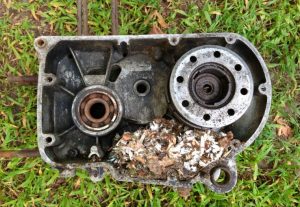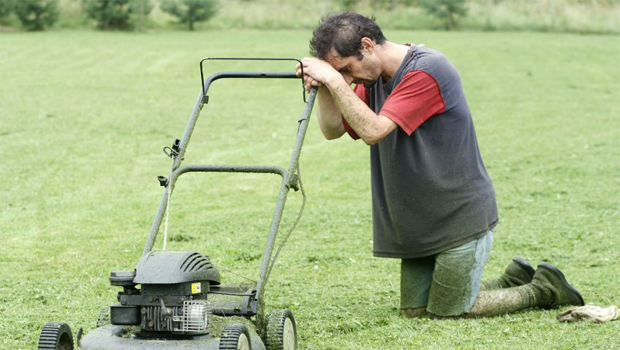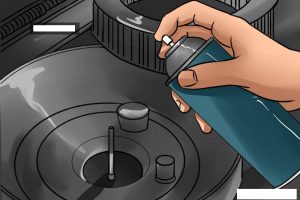It’s still winter – but not for too much longer. Which means not too long from now, many of us will be pulling cords to lawnmowers and firing up motorcycles (and classic cars) that have been in hibernation for the past several months.
Will they start?
You’ve probably read about adding fuel stabilizer to the tank of any machine that’s going to sit for awhile and this is definitely sound policy. But if you really want to improve the odds of that machine starting on the first or second pull if it’s a lawnmower – and without having to use ether if it’s an old car or bike – the thing to do is start it once or twice a month during the off season.
And let it run for 15 minutes each time you do.
What this will do is burn the fuel that’s sitting in the carburetor, filling it with fresh (or at least, fresher) fuel that hasn’t been sitting for weeks/months in the carburetor. Even with fuel stabilizer, today’s ethanol-laced gas sometimes reacts with the plastic and rubber parts inside carburetors. The gunk that results is what leads to hard (or no) starting come spring.
Running the engine will also run fuel through internal passages (jets, fuel circuits, etc.) within the carb, and since gas is a solvent this will help keep those often tiny orifices clear. A partially clogged pilot jet is the cause of many hard (and no-start) problems.
And even if the carburetor is clean, running the engine once or twice a month during the off season has other benefits as well. It helps keep the battery charged (if the machine has one) and the heat of normal operation will help burn off any condensation within the engine while also circulating fresh oil to all the moving parts.
The heat – and noise – serves another worthy purpose, too:
It will alarm any rodent that has decided to make your machine its winter home. Mice love the nooks and crannies that lawnmower/motorcycle and old car engines often offer. For this reason, it’s good policy to look in the air cleaner housing and all around the engine generally prior to starting it. If a mouse has belt a nest in the air box, you don’t want the straw, chewed-up newspaper and other bedding going down the throat of your carb. You also don’t want that stuff to catch fire, either.
Be sure to run the engine for at least 15 minutes, too. This is so that it reaches normal operating temperature. You want everything to get good and hot. If you only run it for a couple of minutes – not long enough for everything to get good and hot – you may do more than harm than good. In older stuff with carburetors, unburned fuel can dilute the oil, wash away the protective film of oil on wear critical parts – and so on. Also, if the machine has a battery, running it for just a few minutes won’t give the alternator time enough to restore full charge (a trickle charger/tender remedies this, but the point remains).
If it’s a classic car or a motorcycle, it’s even better to take it for a 15 minute drive or ride. This will let you run the engine and the transmission – as well as other moving parts.
Speaking of that, even if you can’t drive/ride whatever it is, try to move it around a little – so that the weight of the vehicle isn’t sitting on the same spot on the tires for weeks/months at a time.
Weather/conditions may make it hard to drive/ride . . . outside of your garage. But you can go for a drive without leaving your garage. If you have an old car – which is probably a rear-drive car – jack (and support) the rear axle, leaving both rear wheels a couple inches off the ground. Be sure the rear of the car is thoroughly supported, a jack stand on either side of the differential and a floor jack under the axle.
Now you can go for a drive in your garage. Warm the engine up, put it in Drive (or shift into first) and off you go. Keep your “speed” low – to reduce vibrations – and just pretend you’re cruising through the neighborhood. Apply the brakes every now and then – this will burn off rust forming on the discs and help keep caliper pistons (and wheel cylinders) limber.
You can do the same with a bike, too – just get the rear wheel off the ground enough to allow free movement and make sure the bike is stable while you do it.
Do this stuff and your stuff will start right up a few weeks from now!
. . .
Got a question about cars – or anything else? Click on the “ask Eric” link and send ’em in!
If you like what you’ve found here, please consider supporting EPautos.
We depend on you to keep the wheels turning!
Our donate button is here.
If you prefer not to use PayPal, our mailing address is:
EPautos
721 Hummingbird Lane SE
Copper Hill, VA 24079
PS: EPautos magnets – they’re back! are free to those who send in $20 or more to support the site. Also, the eBook – free! – is available. Click here. Just enter you email in the box on the top of the main page and we’ll email you a copy instantly!













I only use non ethanol gas in my mower and yard equipment – makes a big difference – I used to have problems every spring. I take my carbed bike out every 2-3 weeks through the winter for a good 15 – 20 miles and run non ethanol gas in it during the winter too.
I run mine out every fall, never had a problem,people that have problems with E10, usually bring out on themselves, I also have on pretty good authority a lot of these “Flex Fuel” come off the same lines as the other ones .
Good advice, unless you live where it’s 20 below zero much of the time. The thought of trying to start my mowers when it’s that cold and they all have straight 30-weight oil in them is a daunting one.
Fortunately, gas stabilizer really works. Decades of fresh, stabilized gas run through the summer machines at the same time fresh oil is put into them in the fall have left a perfect record: never a gummed up, balky mower or emergency generator. A little ether sometimes to get one or two started after sitting for months, and they run great. Every time.
Hi Ross,
It’s snowing here in SW Virginia; but not 20 below. This dude could not abide that! We had an unusually cold (for the area) January, with temps in the single digits for several weeks. It was awful. I’m a runner – and that kind of cold keeps me inside. If there’s several inches of snow out, it makes running all but impossible. Add dark at 4 and I’m ready to put a shotgun in my mouth. I don’t know how you guys stand it!
In fact the older I get the less I can stand it, despite being born and raised here. Not much I can do about it now. We’ve had a very cold winter this time around and were getting sub-zero temps at night as recently as a few nights ago. Not much for snowfall, fortunately. But there’s hope on the horizon: noticeably longer days and maybe 40 degrees later this week!
Hi Anonymous,
We got about four inches of snow and it’s in the low 20s outside. A kick in the teeth after a couple weeks of 50s and 60s and no got-damned snow!
I never run ethanol gas in stuff with a carb. My Stihl weedwacker sets all winter in a unheated shed with my riding lawnmower, with no treatment, start up everytime. Even my 94 F150 is worth running the stuff in. I get 17 mpg running it vs. 11-12 on regular 87 E10. The .50-1.00 difference is worth it.
Pure-gas.org
I am glad I don’t own Fords ,I have heard other Ford owners claim the straight gas gave them fantastic mileage over E10, it makes so little difference in my Dodge pickup or the three Hondas as to be unnoticeable.
I used to bleed for Ford and staunchly defend them, not anymore.
A funny thing happened on the way to the Forum, all the non -alcohol grades command a premium price and our local dealer claimed their overpriced premium was Ethanol free( maybe it is , a large number of blenders use ethanol to increase the octane rating of their gas) imagination and belief are a powerful force, you are getting – 40% or better mileage just running gas that doesnt have alcohol( 10 percent%? never heard of alcohol having negative mileage) worst case you should probably get 95% percent of the mileage running E10, maybe the truck needs a tuneup .I watched the dyno pull on e85, used bigger jets but actually produced more horsepower and the engine undoubtedly wasn’t using twice as much, it used more because the btu content of the alcohol was less , but it wasn’t negative. In parts of South America( the only place were it makes economic sense to run the stuff) they run pure alcohol or blends , the biggest problem seems to be getting a cold engine to fire up on the stuff.
I have heard of e85 knocking the mileage way down , a former boss and His cronies were out West and taking turns buying gas for the trip in the land ark Suburban( modern one) now Ol”Bossy Man was a fuss budget and the Suburban was a “Flex Fuel ” vehicle , Boss was gloating as He filled the tank with E85 , mileage promptly went from 17 mpg to 12 mpg and the Guys wouldn’t make up the difference , all in all the cost was probably similar( because the E blends are heavily subsidized{ stop this cronyism BS already ! ADM is not your friend}) I think it depends on the vehicle and owner bias , you can bet its figured out so you won”t come out ahead .
As for me, I have stopped trying to use straight gas, I couldn’t justify the hassle to get it vs the benefit. The only time I will buy it, is when I need to store it for long periods.
I have learned 2 cvcle engines running alcohol -castor oil mix are one helluva lot less noxious to the user, probably so ,Alcohol burns a lot cleaner.
The only car I had before RFG first put ethanol in the gas was my ’73 Ford. I didn’t notice much of a fuel economy change, just some of the usual issues with a car that old and ethanol. But that’s the thing, one needs a vehicle made before the mid 1990s now to even really notice something amiss with E10.
I always run any ICE powered machine dry of fuel if I am going to store it for any length of time , this system always works for Me, after initially filling and letting the gas trickle down, they start on the second pull.
Starting valve lash/shim maintenance on the Vulcan.
Looking forward to getting back in the wind again.
Hi AF,
I need to attend to that, too! Also have four oil/filter changes to do, chain clean/adjust, etc.
It’s only a few weeks away now…
eric, 87 degrees here today. No doubt the bikes were replete. I first saw a lot 3 or so weeks ago.
One year, I believe 1980, I had an old mower and it ran ok but was nothing to brag about. I removed the plug and poured some diesel or some such into it, let it set for a day and then reinstalled the spark plug and used it. It worked swimmingly and I mowed most of the yard. The next day I pulled on it a cou0ple times and then it locked up. Sheesh, what could it be? I pulled the head and there was one of the biggest chunks of carbon I’ve seen in a motor, jammed between piston and head. It had cut into it enough I just drug it off and forgot about it.
That same year we moved into a house with a fireplace so I bought a chainsaw, a Roper made saw from Sears. I used it properly a little bit and then set it aside to let it cool and wait till the next day to use it again since it was new. Next day I pull the rope and it suddenly stops. I recalled the lawnmower but nah, that wasn’t it, the thing had thrown the nuts on the conrod and was locked up.
So I take it back and the (notorious, I’d later find out)female manager wouldnt’ take it back with half hour of run time and give me another. She said she would have it repaired. I said I wanted my money back and she starts making out a check. Nope, I paid cash and that’s what I’ll take so she cleans out the register and gives me the cash.
I go down to a friends shop and told him about it. He said “There’s more than one way to skin a cat” so we loaded up, went back down there not 15 minutes after I left, hands her the cash she’d given me and said he wanted to order a new chainsaw, just like that one sitting there. It was a good victory and we still laugh about it.
“jammed between the piston and cylinder wall” and it was a huge chunk.
Another engine to start regularly is your back up generator. I usually keep mine empty and just put enough fuel in to run it with an electric space heater or the shop vac as a load for about 20 minutes or so. Even though it’s a Horrible Fright (er, Harbor Freight) device, it always starts first or second pull and keeps a pretty even waveform.
I fill my generators’ tanks with stabilized fuel once a year and leave them full. That eliminates interior condensation and (allegedly) keeps the seals and petcock from drying up. I start them twice a year in order to change oil from winter weight to summer weight, and back. It’s worked well so far.